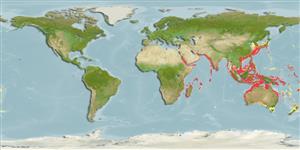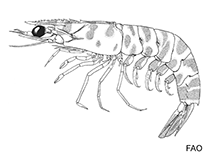Parapenaeus fissuroides Crosnier, 1986
| Native range | All suitable habitat | Point map | Year 2050 |

|
| This map was computer-generated and has not yet been reviewed. |
| Parapenaeus fissuroides AquaMaps Data sources: GBIF OBIS |
Upload your photos
Google image | No image available for this species;
drawing shows typical species in Penaeidae.
Google image | No image available for this species;
drawing shows typical species in Penaeidae.
Classification / Names Common names | Synonyms | CoL | ITIS | WoRMS
Malacostraca | Decapoda | Penaeidae
Environment: milieu / climate zone / depth range / distribution range Ecology
Benthic; depth range 60 - 399 m (Ref. 78901), usually 60 - 200 m (Ref. 76930). Tropical
Distribution Countries | FAO areas | Ecosystems | Occurrences | Introductions
Indo-West Pacific: Red Sea to Japan, Philippines and Indonesia. Pérez Farfante (Ref. 75620) recognizes 3 subspecies: Parapenaeus fissuroides fissuroides from Indonesia to Japan and the Philippines, Parapenaeus fissuroides erythraeus from the Red Sea and Parapenaeus fissuroides indicus from east Africa and Madagascar.
Length at first maturity / Size / Weight / Age
Maturity: Lm ? range ? - ? cm Max length : 2.7 cm CL male/unsexed; (Ref. 119007); 3.61 cm CL (female)
Found in high salinity and high temperature areas (Ref. 76930).
Life cycle and mating behavior Maturity | Reproduction | Spawning | Eggs | Fecundity | Larvae
Members of the order Decapoda are mostly gonochoric. Mating behavior: Precopulatory courtship ritual is common (through olfactory and tactile cues); usually indirect sperm transfer.
Main reference
References | Coordinator | Collaborators
Pérez Farfante, I. and B. Kensley. 1997. (Ref. 75620)
IUCN Red List Status (Ref. 130435)
CITES status (Ref. 108899)
Not Evaluated
CMS (Ref. 116361)
Not Evaluated
Threat to humans
Human uses
| FishSource |
Tools
More information
Internet sources
BHL | BOLD Systems | CISTI | DiscoverLife | FAO(Publication : search) | Fishipedia | GenBank (genome, nucleotide) | GloBI | Gomexsi | Google Books | Google Scholar | Google | PubMed | Tree of Life | Wikipedia (Go, Search) | Zoological Record



